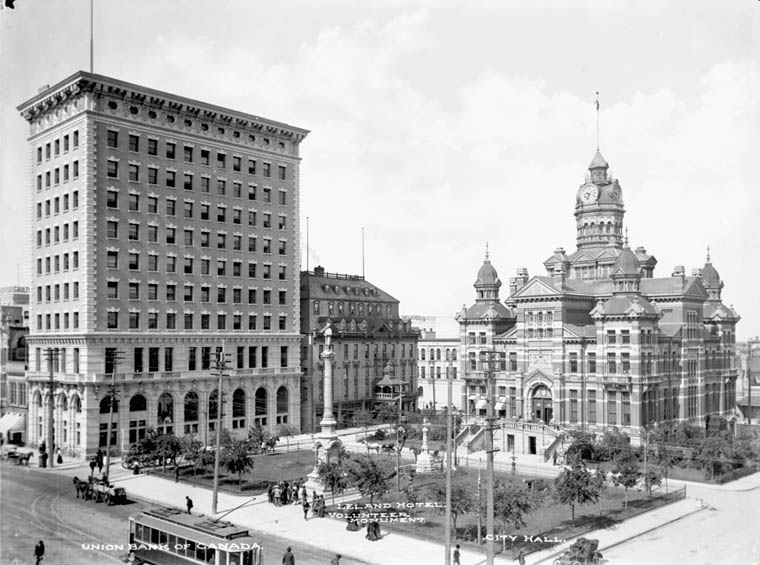Union Bank Of Canada on:
[Wikipedia]
[Google]
[Amazon]
The Union Bank of Canada was a Canadian chartered bank which operated 1865–1925, primarily in the Canadian Prairies.

Governance
The order of bank presidents was Charles Levy, Andrew Thomson, John Sharples, John Galt, and W.R. Allan.
Earlier expansion
Founded as the Union Bank of Lower Canada in Quebec City in 1865, the name changed to the Union Bank of Canada in 1886. The first Winnipeg branch opened in 1882. Over the next 20 years, hundreds of branches existed for varying periods in rural Prairie communities for brokering land deals and lending to farmers. In many places, this was the only bank operating. Being the first to develop an extensive branch network throughout the Prairie provinces, the institution became known as the "pioneer bank" of Western Canada. In 1904, the 10-storey (plus mezzanine floor)Union Bank Building
The Union Bank Building ( the Union Bank Tower or Former Union Bank Building and Annex), located in the Exchange District of Winnipeg, Manitoba, is the first skyscraper in Canada, once forming the northern end of Main Street, Winnipeg, Main Stre ...
in Winnipeg was completed.
United Empire Bank of Canada
In 1903, the legislative banking committee approved the bill to incorporate the Pacific Bank of Canada with the head office in Victoria. In 1905, an extension was requested while awaiting a Treasury Board certificate to operate as a chartered bank. That year, application was made to rename the company as the United Empire Bank of Canada with Toronto as the head office and to increase the authorized capital from $2 million to $5 million. In 1906, the banknotes issued were printed by the American Bank Note Co in $5 and $10 denominations. When the Union Bank purchased the United Empire in 1911, the latter had 25 branches, prior to closures because of duplications with the Union Bank.Further expansion
At the end of 1911, the rationalized network totalled 242 branches, which comprised 1 in New Brunswick, 1 in Nova Scotia, 76 in Ontario, 7 in Quebec, 39 in Manitoba, 67 in Saskatchewan, 39 in Alberta, 11 in British Columbia, and 1 in London, England. To be closer to the centre of branch activity, the headquarters moved to Winnipeg in 1912. Yearend branch totals were 285 in 1912, 310 in 1913, 390 in 1919, and 393 in 1920. In 1919, the Union Bank launched a joint venture with the National Park Bank to bring banking services to the Far East. From the New York head office, the Park-Union Bank managed offices in Shanghai, Tokyo, Yokohama and Paris.Banknotes
Demise
In June 1923, the announcement of a $4.25 million increase in the provision to cover bad loans followed falling stock prices and the retirement of some senior management. Even parliament was debating the stability of the bank. The failure of the Home Bank of Canada in August 1923, immediately followed by the insolvency of theBank of Hamilton
The Bank of Hamilton was established in 1872 by local businessmen in the city of Hamilton, Ontario, Canada under the leadership of Donald McInnes, the bank's first President. Like the other Canadian chartered banks, it issued its own paper money. ...
and Banque Nationale, undermined confidence in the banking sector, especially regarding the future of the Union Bank. However, at least publicly, the Union Bank continued to proclaim its soundness and strength.
During the finalization of merger talks with the Royal Bank of Canada
Royal Bank of Canada (RBC; french: Banque royale du Canada) is a Canadian multinational financial services company and the largest bank in Canada by market capitalization. The bank serves over 17 million clients and has more than 89,000& ...
in May 1925, the Union Bank had
327 branches of which about 50 were at points of duplication with the Royal. The Union Bank had 320 Canadian branches (204 in the Prairies) at the time of absorption into the Royal that September. The 270 to remain open were rebranded.
Historic buildings
. Municipal designationSee also
* Defunct and merged banks in Canada *Canadian chartered bank notes
Between 1871 and 1944, Canadian chartered banks were authorized to issue bank notes for circulation in Canada. In 1899, they were invested with the additional authority to issue bank notes for circulation in any British colony or possession. For s ...
References
{{reflist Defunct banks of Canada Banks established in 1865